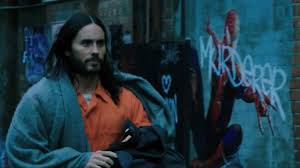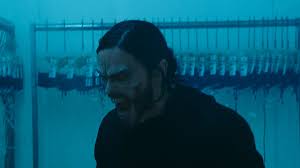Morbius (2022)

Morbius (2022) Review: A Flawed Antihero Film with Missed Potential
Morbius (2022), directed by Daniel Espinosa and starring Jared Leto, is Sony’s attempt to expand its Spider-Man-related universe by introducing the infamous Marvel antihero, Dr. Michael Morbius. The film follows the origin story of a biochemist who, in his desperate search for a cure to a rare blood disorder, accidentally transforms himself into a living vampire. While Morbius had great potential, particularly given its compelling comic book roots and strong lead actor, it ultimately fails to deliver a satisfying cinematic experience due to weak storytelling, lackluster CGI, and an underwhelming connection to the broader Spider-Man universe.
Plot Summary
Dr. Michael Morbius (Jared Leto) is a renowned scientist suffering from a debilitating blood disease. Determined to find a cure, he develops an experimental treatment using vampire bat DNA. While the experiment initially appears to be a success, granting him superhuman strength, agility, and echolocation abilities, it also comes with a horrific price—an insatiable thirst for human blood.
As Morbius struggles with his newfound vampiric condition, his childhood friend Milo (Matt Smith), who also suffers from the same disorder, becomes obsessed with the potential of Morbius’ serum. Unlike Morbius, who attempts to control his urges, Milo fully embraces his monstrous transformation, leading to a deadly conflict between the two.
The Strengths of Morbius
1. Jared Leto’s Performance
Leto delivers a committed performance as Morbius, portraying both his physical frailty at the start and his powerful, yet tormented, post-transformation state. While his performance is not groundbreaking, he effectively captures the inner turmoil of a man battling his monstrous nature.
2. A Dark, Horror-Influenced Tone
Unlike many other superhero films, Morbius attempts to embrace a horror-infused aesthetic, reminiscent of classic monster movies. The film leans into eerie, dimly lit settings and fast, erratic transformations, which provide some genuinely suspenseful moments.
3. Action Scenes and Visual Effects
While the CGI is inconsistent, certain action sequences are visually engaging, particularly those that highlight Morbius’ speed and agility. The slow-motion sequences, echo-location effects, and vampire flight mechanics add an interesting visual flair to his powers.
Where Morbius Fails
1. Weak Story and Script
One of the biggest issues with Morbius is its uninspired screenplay. The dialogue often feels unnatural, and the film rushes through crucial character developments. Key emotional moments lack depth, making it difficult for the audience to connect with the protagonist’s struggle.
2. Poorly Developed Villain
Milo, played by Matt Smith, starts off as a sympathetic character but quickly devolves into a one-dimensional antagonist. His motivations are underdeveloped, and his transformation into a villain feels rushed and unconvincing. While Smith’s performance is energetic, the script fails to give him enough depth to make him a compelling adversary.
3. Pacing and Structure Issues
The film struggles with pacing, often jumping from one scene to another without allowing crucial moments to breathe. The first act effectively sets up Morbius’ condition, but the latter half of the film feels rushed, leaving many questions unanswered. The climactic battle between Morbius and Milo is disappointingly brief and anticlimactic.
4. Inconsistent CGI and Visuals
Despite a few visually appealing sequences, Morbius suffers from inconsistent CGI. Some transformation effects look impressive, while others appear unfinished. The film’s attempt to visualize Morbius’ echolocation powers is ambitious, but at times, it feels overdone and distracting.
The Post-Credit Scenes and Sony’s Confusing Universe Building
One of the most criticized aspects of Morbius is its post-credit scenes, which attempt to connect the film to the greater Spider-Man universe. The inclusion of Michael Keaton’s Adrian Toomes (a.k.a. Vulture) feels forced and confusing, leaving fans questioning the logic behind Sony’s interdimensional storytelling. Rather than building excitement for future crossovers, these scenes come across as haphazardly inserted and poorly explained.
Missed Potential: What Morbius Could Have Been
Given the rich history of the Morbius character in Marvel Comics, this film had the potential to be a unique, darker take on the superhero genre. A deeper exploration of Morbius’ moral dilemmas, the horror aspects of his transformation, and a more complex villain could have elevated the film. Instead, Morbius settles for a generic superhero formula without committing fully to its horror or action elements.
Critical Reception and Audience Response
Upon release, Morbius was met with overwhelmingly negative reviews from critics. It holds a low score on Rotten Tomatoes, with many critics citing its weak script, poor pacing, and lackluster character development. However, the film did gain an ironic cult following due to its internet meme status, particularly the phrase “It’s Morbin’ Time,” which trended on social media despite never being said in the film.
Final Verdict: A Forgettable Entry in Sony’s Spider-Man Universe
Morbius had the potential to be a fascinating and unique addition to the superhero genre, but its weak script, rushed pacing, and inconsistent CGI prevent it from standing out. While Jared Leto and Matt Smith give their best efforts, they are let down by a poorly developed story that fails to explore the depth of its characters.
For hardcore Marvel fans, Morbius might still be worth a watch, but for general audiences, it is a forgettable and frustrating missed opportunity. If Sony intends to continue expanding its Spider-Man-related universe, future films will need to focus on stronger storytelling, better character development, and a more cohesive connection to the larger Marvel universe.
Final Rating: 4/10










